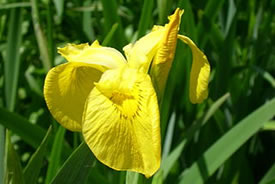
Yellow flag iris (Photo from Wikimedia Commons)
Yellow iris
While it can be an attractive perennial often sold in nurseries, the yellow iris is an invasive species that poses a great threat to fragile wetland ecosystems, such as Baikie Island. Unless tackled early, the iris can rapidly form dense cover, preventing the establishment of native wetland plants, which in turn can support far more native animal species. This flower is native to Europe, western Asian and northwest Africa.
How is it identified?
The flowers have three drooping, deep-yellow sepals with purple-brown markings that look like large petals, surrounding three smaller upright petals. It is the only iris in North America with entirely yellow flowers that bloom between April to July.
Where does it grow?
The first recorded Canadian sighting of yellow iris was in Newfoundland in 1911. It was found in Ontario in 1940. Today it grows in most Canadian provinces, including parts of southern Ontario, Quebec, Nova Scotia, Newfoundland, New Brunswick, the east coast of Prince Edward Island and the west coast of British Columbia.
How does it grow?
Once the iris forms seed pods, these seeds spread rapidly in a wetland environment because they float. Within a few years, thick roots spread underground, making eradication far more difficult since the smallest root fragment remaining in the soil can support a new plant. By hitting the iris at an early growth stage, staff and volunteers are able to make light work of the plants.
What is NCC doing to control this species?
Conservation Volunteers have tackled the spread of yellow iris on the Baikie Island Reserve. It didn't take long for them to put a significant dent in the population of this invasive flower.




